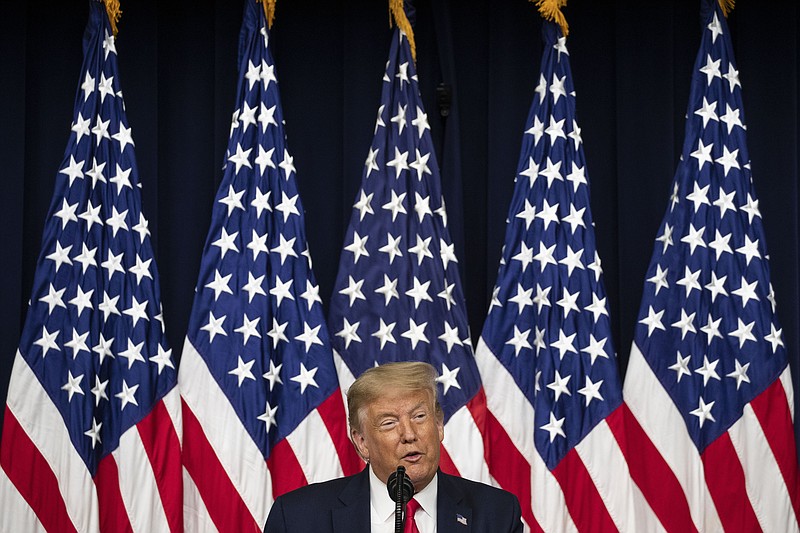National news agencies and polling organizations are desperate not to be wrong about their periodic reports in this year's presidential race, but trust us they are running scared.
You know why.
They all blew it in 2016 when no legitimate organization predicted Donald Trump would win the White House. Today, if you look hard enough, you'll find individuals who said they saw it coming and agencies that explain away their results by saying the possibility was always there through the margin of error.
But it surely was the biggest surprise in presidential elections at least since the 1948 campaign, when incumbent Harry Truman knocked off the favorite, New York Gov. Thomas Dewey, and maybe throughout presidential campaign history.
Every four years, Labor Day marks the start of the last sprint of the presidential campaign. And traditionally it's been a day when news organizations and pollsters update voters on where the candidates stand.
"Labor Day used to be this big, important marker in the campaign season," Amy Walter, the national editor at the nonpartisan Cook Political Report, told The New York Times in 2016. "A kickoff, if you will. Today, it feels like the start of the third quarter instead of the kickoff."
This year, as in 2016, the Democratic contender, former Vice President Joe Biden, will be reported in the lead. The Real Clear Politics national average, late last week, put the race in his favor by 6.3%. Four years ago, the latest NBC News|SurveyMonkey Weekly Election Tracking Poll gave Hillary Clinton a six-point lead. Other polling agencies had it a little closer, but all believed her lead would expand.
In early September, The New York Times projected she had an 86% chance of winning in November, FiveThirtyEight put her chances at 69% and Upshot said the likelihood of her winning was 84%.
The Guardian talked of the possibility of her winning "by a landslide," and New York Magazine said "everything at this point suggests a Hillary Clinton win by a national popular vote and electoral vote margin similar to that won by Barack Obama in 2012, which could, with luck and skill (or missteps by Trump), begin to resemble Obama's margin in 2008."
(Clinton did, in fact, win the popular vote by nearly 2.9%.)
Lots of things happen between Labor Day and the election. In 2016, they actually got worse for Trump with The Washington Post's revelation of the Access Hollywood tape in which he and television host Billy Bush had "an extremely lewd conversation about women."
In 2008, a late August poll had Democratic Sen. Barack Obama up by eight points over Republican Sen. John McCain, but an early September poll had McCain up by five points. A late September poll still had them tied. But the Sept. 29 stock market crash, and subsequent economic emergency, put Obama in the lead to stay.
In five other presidential campaigns in the last 60 years, a different candidate than the eventual winner of the race was ahead in one or more of the polls in late August or early September.
* In 1960, in polls around Labor Day, then-Vice President Richard Nixon led Sen. John F. Kennedy by six points in surveys by one organization and by one point in another. Kennedy led by one point in one poll, and the two were tied in another. Kennedy, largely through the strength of a strong debate performance over a sickly Nixon, won the popular vote by .1%.
* In 1980, President Jimmy Carter had a one-point lead over challenger Ronald Reagan in two polls, and a third poll had the race tied. When the votes were counted - the Iranian hostages captured a year earlier still not home - Reagan easily won, taking the popular vote by 10.7%.
* In 1988, August-September polls swung from Massachusetts Gov. Michael Dukakis leading by seven points to Vice President George H.W. Bush on top by five. Bush wound up winning by 7.8% of the popular vote.
* In 2000, the roller-coaster polls around Labor Day were an accurate picture of the fiercely close result. The last three August polls showed Vice President Albert Gore Jr. up by two points, then Texas Gov. George W. Bush up by one. In September, they gave Gore a three-point lead, then Bush a one-point advantage, then Gore a seven- and then eight-point lead. In the end, of course, Bush narrowly won the Electoral College vote but lost the popular vote by .5%.
* In 2012, most polls around Labor Day gave President Obama a lead of one to four points, but one poll gave the challenger, former Massachusetts Gov. Mitt Romney, a one-point lead. Obama went on to win the popular vote by 4%.
So, when the next 57 days are up and the election arrives, will the results resemble 2016, when pollsters were unable to gauge the support Trump had because his supporters wouldn't tell them? Or will something that occurs - the approval of a vaccine for the coronavirus, say - change the minds of the electorate? Or might the race seesaw like some of those mentioned above?
On Labor Day, it's all speculation. Of course, in 2020, in this most unusual of years, something totally unexpected might happen. But take heart, in less than two months - plus another several months of counting mail-in ballots - it'll all be over.
